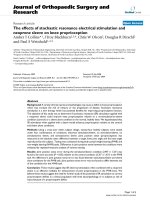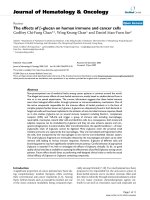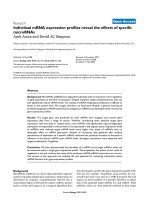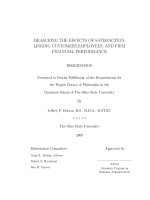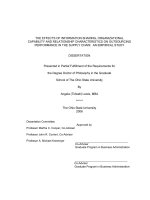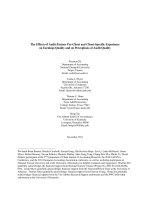The effects of efl listening speaking portfolios students learning of efl listening, speaking skills and their perception towards learner autonomy m a
Bạn đang xem bản rút gọn của tài liệu. Xem và tải ngay bản đầy đủ của tài liệu tại đây (1.97 MB, 180 trang )
VIETNAM NATIONAL UNIVERSITY –HOCHIMINH CITY
UNIVERSITY OF SOCIAL SCIENCES & HUMANITIES
FACULTY OF ENGLISH LINGUISTICS & LITERATURE
THE EFFECTS OF EFL LISTENING-SPEAKING
PORTFOLIOS ON STUDENTS’ LEARNING OF EFL
LISTENING, SPEAKING SKILLS AND THEIR
PERCEPTION TOWARDS LEARNER AUTONOMY
A thesis submitted to the
Faculty of English Linguistics & Literature
in partial fulfillment of the Master’s degree in TESOL
By
PHÙNG THANH LOAN
Supervised by
ĐẶNG TẤN TÍN Ph.D.
HO CHI MINH CITY, SEPTEMBER 2016
VIETNAM NATIONAL UNIVERSITY –HOCHIMINH CITY
UNIVERSITY OF SOCIAL SCIENCES & HUMANITIES
FACULTY OF ENGLISH LINGUISTICS & LITERATURE
THE EFFECTS OF EFL LISTENING-SPEAKING
PORTFOLIOS ON STUDENTS’ LEARNING OF EFL
LISTENING, SPEAKING SKILLS AND THEIR
PERCEPTION TOWARDS LEARNER AUTONOMY
A thesis submitted to the
Faculty of English Linguistics & Literature
in partial fulfillment of the Master’s degree in TESOL
By
PHÙNG THANH LOAN
Supervised by
ĐẶNG TẤN TÍN Ph.D.
HO CHI MINH CITY, SEPTEMBER 2016
ACKNOWLEDGEMENTS
The process of writing this thesis has been one of the most challenging but
valuable experiences in my life. Even though this is my individual work, it has
involved many other people whose kindness and support earned them my deep
gratitude.
I would first like to thank my thesis supervisor – Dr. Đặng Tấn Tín of the Faculty
of Foreign Languages, Ho Chi Minh City University of Technology and
Education. He has been consistently supportive to me from the beginning to the
completing stage of doing this thesis. In spite of allowing this thesis to be my own
work, he always steered me in the right direction when he thought I needed it.
Besides, his expertise, strong work ethic, and enthusiasm have always inspired me
to take on commitment to fulfill the thesis no matter how many challenges I
encountered along the process.
I would also like to thank the instructors of the Master program at the Faculty of
English Linguistics and Literature, and Informatics and IT center, University of
Social Sciences and Humanities. Their devoted and enthusiastic teaching and
guidance in the constituent courses have provided me with profound knowledge
and essential academic skills to carry out this study.
My special thanks also go to my colleagues, especially Ms. Hoàng Ngọc Trang of
the Faculty of Foreign Languages, Ho Chi Minh City University of Technology
and Education and Ms. Nguyễn Thu Hồng of Faculty of Fundamental Sciences,
PetroVietnam University. Without their discussion and encouragement, I may not
have been able to overcome occasional trouble spots when doing this research. I
would also like to acknowledge my students who eagerly participated in the two
investigated Speaking classes. Even though they were unaware of the experiment,
their committed learning helped me gain sufficient and reliable data for the study.
i
Finally, I must express my gratitude to my family for their unconditional love,
sympathy, support, and encouragement throughout the years of study and the
process of doing and writing this thesis. This accomplishment would not have been
possible without them.
ii
STATEMENT OF ORIGINALITY
I hereby certify my authorship of the thesis submitted today
entitled:
THE EFFECTS OF EFL LISTENING-SPEAKING
PORTFOLIOS ON STUDENTS’ LEARNING OF EFL
LISTENING, SPEAKING SKILLS AND THEIR
PERCEPTION TOWARDS LEARNER AUTONOMY
In terms of the statement of the requirements for the Thesis in
Master’s Program issued by the Higher Degree Committee.
This thesis has not been submitted for the award of any degree or
diploma in other institution.
Ho Chi Minh City, September 2016
PHÙNG THANH LOAN
iii
RETENTION OF USE
I hereby state that I, Phùng Thanh Loan, being the candidate
for the degree of Master in TESOL, accept the requirements of the
University relating to the retention and use of Master’s Thesis
deposited in the library.
In terms of these conditions, I agree that the original of my
thesis deposited in the library should be accessible for the purpose
of study and research, in accordance with the normal conditions
established by the library for the care, loan or reproduction of
theses.
Ho Chi Minh City, September 2016
iv
TABLE OF CONTENTS
ACKNOWLEDGMENTS ......................................................................................... i
STATEMENT OF ORIGINALITY .........................................................................iii
RETENTION OF USE............................................................................................. iv
TABLE OF CONTENTS .......................................................................................... v
LIST OF ABBREVIATIONS ................................................................................viii
LIST OF TABLES ................................................................................................... ix
LIST OF FIGURES .................................................................................................. x
ABSTRACT ............................................................................................................. xi
CHAPTER 1: INTRODUCTION ............................................................................. 1
1.1.
Context of the study .................................................................................... 3
1.1.1. The general context of the study ............................................................... 3
1.1.2. The specific context of the study .............................................................. 6
1.2.
Aims of the study......................................................................................... 9
1.3.
Research questions ...................................................................................... 9
1.4.
Significance of the study ............................................................................. 9
1.5.
Scope of the study ..................................................................................... 10
1.6.
Organization of the study .......................................................................... 10
CHAPTER 2: LITERATURE REVIEW ................................................................ 12
2.1.
E-portfolios in language education............................................................ 12
2.1.1. Definition of e-portfolios ........................................................................ 12
2.1.2. Classification of e-portfolios .................................................................. 13
2.1.3. Components of e-portfolios .................................................................... 15
2.1.4. Speaking e-portfolios .............................................................................. 16
2.1.5. Challenges of using e-portfolios ............................................................. 22
2.1.6. Benefits of using e-portfolios…………………………………………..23
2.2.
Learner Autonomy..................................................................................... 31
2.2.1. Definition of learner autonomy .............................................................. 31
2.2.2. Versions of learner autonomy ................................................................. 32
2.2.3. Learner autonomy promoting principles in the current study ................ 36
v
2.2.4. Conceptual framework of the study ........................................................ 38
Chapter Summary ................................................................................................ 41
CHAPTER 3: METHODOLOGY .......................................................................... 42
3.1. Research questions ........................................................................................ 42
3.2. Research design ............................................................................................ 42
3.3. Context of the study ...................................................................................... 44
3.4. Participants .................................................................................................... 45
3.5. Platform and Development Process of SEP for TG ...................................... 48
3.6. Speaking Assignments for Both Groups ....................................................... 50
3.7. Instruments .................................................................................................... 52
3.7.1. Questionnaire .......................................................................................... 52
3.7.2. Speaking pre-test and post-test ............................................................... 54
3.7.3. Validity and Reliability........................................................................... 55
3.8. Data Collection Procedure ............................................................................ 57
3.8.1. Questionnaire .......................................................................................... 57
3.8.2. Speaking pre-test and post-test ............................................................... 57
3.9. Framework of data analysis .......................................................................... 58
3.9.1. Statistical method for the questionnaire ................................................. 59
3.9.2. Statistical methods for students’ speaking pre-test and post-test ........... 59
Chapter Summary ................................................................................................ 60
CHAPTER 4: RESULTS AND DISCUSSION ...................................................... 61
4.1. Analysis of data............................................................................................. 61
4.1.1. Distribution of the questionnaire data ..................................................... 61
4.1.2. Reliability of the questionnaire ............................................................... 62
4.1.3. Inter-rater reliability of TG and CG students’ scores rated by two scorers
in speaking pre-test and post-test ...................................................................... 66
4.1.4. The extent to which SEP improved learner autonomy dimensions ........ 67
4.1.5. The impact of SEP on students’ achievement in learning speaking skills
........................................................................................................................... 74
4.2. Discussion ..................................................................................................... 78
vi
4.2.1. The extent to which learner autonomy dimensions were promoted by
SEP .................................................................................................................... 78
4.2.2. The impact of SEP on students’ achievement in the speaking course.... 83
4.2.3. The impact of SEP on learner autonomy dimensions and students’
speaking achievement ....................................................................................... 90
Chapter summary ................................................................................................. 92
CHAPTER 5: CONCLUSION ............................................................................... 93
5.1. Summary of the study ................................................................................... 93
5.2. Recommendations ......................................................................................... 96
5.3. Limitations .................................................................................................... 98
5.4. Contributions of the study............................................................................. 99
5.5. Suggestions for future research ................................................................... 101
REFERENCES...................................................................................................... 102
APPENDIX 3A: Guidelines for Peer-reflection on Speaking Assignments ........ 112
APPENDIX 3B: Guidelines for Self-reflection on Speaking Assignments ......... 114
APPENDIX 3C: Guidelines for Conference Reflection ....................................... 117
APPENDIX 3D: Course Description .................................................................... 118
APPENDIX 3E: Congruence of the Course Schedule and SEP Speaking
Assignments .......................................................................................................... 121
APPENDIX 3F: Questionnaire – English Version ............................................... 124
APPENDIX 3G: Questionnaire – Vietnamese Version ........................................ 126
APPENDIX 3H: Speaking Pre-test ....................................................................... 131
APPENDIX 3I: Speaking Post-test ....................................................................... 133
APPENDIX 3J: Marking Scheme for Speaking Pre-test ...................................... 135
APPENDIX 3K: Marking Scheme for Speaking Post-test ................................... 136
APPENDIX 4A: Output of Normal Distribution Test .......................................... 137
APPENDIX 4B: Output of Cronbach’s Alpa Computation ................................. 158
vii
LIST OF ABBREVIATIONS
EFL: English as a Foreign Language
ELP: European Language Portfolio
SEP: Speaking e-portfolio
TG: Treatment group
CG: Control group
viii
LIST OF TABLES
Table 2.1: Six types of e-portfolios classified by IMS Global Learning Consortium ........ 15
Table 3.1: Differences in the requirements for TG and CG students to submit and
reflect on speaking assignments........................................................................ 47
Table 3.2: Schedule for SEP speaking assignments and conference ................................. 50
Table 3.3: Speaking assignments for both group ............................................................... 51
Table 3.4: Learner Autonomy dimensions/ sub-dimensions operationalized in the
study and the equivalent items in the questionnaire. ........................................ 54
Table 4.1: An Extract of Skewness and Kurtosis Values of 51 Items Regarding
Learner Autonomy Dimensions......................................................................... 62
Table 4.2: Cronbach’s Alpha coefficients for ten investigated learner autonomy
sub-dimensions. ................................................................................................. 64
Table 4.3: Summary of items deleted and highest possible Alpha for each scale ............. 65
Table 4.4: Inter-rater reliability of TG and CG students’ scores rated by two
scorers in speaking pre-test and post-test......................................................... 66
Table 4.5: Comparison of TG and CG students’ involvement in learning process ........... 69
Table 4.6: Mean differences of two groups on Learner Involvement dimension ............... 70
Table 4.7: Comparison of TG and CG students’ ability to use English
appropriately ..................................................................................................... 71
Table 4.8: Mean difference of two groups on Appropriate Target Language Use
dimension .......................................................................................................... 72
Table 4.9: Comparison of TG and CG students’ ability to reflect on the learning
process and on what they learnt from doing the assignment ............................ 73
Table 4.10: Mean difference of two groups on learner reflection dimension ................... 73
Table 4.11: Mean difference of two groups’ scores in speaking pre-test .......................... 75
Table 4.12: Comparison of TG and CG students’ Speaking Pre-test Scores ................... 75
Table 4.13: Mean difference of two groups’ scores in speaking post-test......................... 76
Table 4.14: Comparison between TG and CG students’ Speaking Post-test Scores ......... 76
Table 4.15: Summary of SEP effects on learner autonomy dimensions and
students’ achievement in learning speaking skills. ......................................... 77
ix
LIST OF FIGURES
Figure 2.1: Common aspects of speaking e-portfolios ............................................ 20
Figure 2.2: Three pedagogical principles to promote learner autonomy ............... 38
Figure 2.3: Conceptual framework of the study ...................................................... 40
Figure 3.1: A snapshot of the interface of the web page ......................................... 48
Figure 3.2: A snapshot of the interface of a student’ SEP on the web site ............. 49
x
ABSTRACT
Emerged in the ESL classroom since the last decade, e-portfolios have been
appreciated and preferred as a promising teaching, learning, and assessing tool.
Studies have been carried out to investigate the role of different e-portfolios in
English language education such as writing e-portfolios, reading e-portfolios, or
speaking e-portfolios. The current research aims at examining the impact of
speaking e-portfolio on learner autonomy and EFL students’ speaking
achievement. The conceptual framework of the study was established by drawing
the thread between learner autonomy promoting principles and e-portfolio aspects.
A speaking e-portfolio system was developed on Moodle software to create a
learning model that enhances learner autonomy and students’ achievement in
learning speaking skills. A quasi-experimental design was conducted with thirty
undergraduate Vietnamese students in two groups over a fifteen-week semester.
Data collected from the questionnaires on learner autonomy revealed promoting
impact of speaking e-portfolios on learner autonomy dimensions. However,
statistical evidence from speaking pre-test and post-tests illustrated that even
though speaking e-portfolios could improve students’ speaking achievement, the
effect of speaking e-portfolios on students’ speaking achievement did not differ
from that of the traditional learning method. Certain reasons were suggested to
contribute to these results. First, the interactive platform of speaking e-portfolios
could make the learning process visible to students. Second, self-reflection and
peer-reflection guidelines could increase learner involvement, and reflective
thinking, thus rendering students more autonomous. However, some extraneous
factors such as insufficient intervention time, students’ dampened motivation, their
unfamiliarity with virtual learning and limited access to technological equipment
aggravated students’ experience with speaking e-portfolios. Recommendations in
terms of preparing technological infrastructure, training students, and designing
and developing speaking e-portfolios were also suggested.
xi
CHAPTER 1: INTRODUCTION
Information technology, especially the World Wide Web, has been making
dramatic changes in human lives by flatting the world and bringing people from
distant territories closer in cyber space for numerous diverse performances. In the
field of education, technological tools such as social network, social media, or web
2.0 have been supporting multi-dimensional interactions among learners and
teachers “through both synchronous and asynchronous channels”, thus opening
“new avenues” for learning and teaching to be undertaken regardless of spatiotemporal confinement of traditional classrooms (Aliweh, 2011, p. 92). Such
influence of information technology appears to well match with the current
pedagogical landscape where constructivist teaching practice is being embraced in
tandem with behaviorism (Alawdat, 2013). According to behaviorists, learning
typically occurred through one-way transmission of knowledge from teachers to
learners, and was then accessed via traditional exams. When the pendulum has
swung to the constructivist end, learning has been regarded as an individualized
and active process nourished through learners’ “cognitive and social development”
within supportive community of teachers, peers and parents (Alawdat, 2013, p.
339; Özdemir-Çağatay’s, 2012). Accordingly, training learners to build up selfmonitoring, reflecting and self-evaluating skills becomes essential to help them
maximize learning efficiency and reach the highest potential within their Zone of
Proximal Development (Vygotsky, 1978; Yudabankan, 2011).
Among different learning and assessing models applied, portfolios introduced to
language education in the early eighties seemed to fit the contemporary
pedagogical scenario (Grant, 2010). They are purposeful collections of students’
work exhibiting their efforts, progress, and achievement. These collections include
students’ participation in selecting content, the criteria for selection, the criteria for
judging merit, and evidence of students’ reflection on their learning (Paulson,
Paulson & Meyer, 1991). With this structure, portfolios are believed to be
beneficial to autonomous learning and academic development (Tran, 2011). These
Chapter 1
Page |1
traditional portfolios were mainly collections of students’ learning artifacts in
general English courses or writing courses – constituting English portfolios and
writing portfolios, respectively.
Under far-reaching influence of information technology, e-portfolios have been
created as an indispensable alternative to its original paper version. Learners’ work
is now stored on CDs, VCDs or in a virtual space such as websites instead of
folders of paper (Aliweh, 2011). Accordingly, besides learning artifacts as written
texts and pictures, e-portfolios enable the inclusion of students’ oral performance
into the digital collection. That has paved the way for the advent of speaking eportfolios. Since its creation, speaking e-portfolios have become appealing to
English language pedagogical attempts and research worldwide (Cepik &
Yastibas, 2013; Hsu, Wang, & Comac, 2008; Huang & Hung, 2010; ƯzdemirÇağatay’s, 2012). It is suggested from the previous research that speaking eportfolios have critical impacts on students’ learning of speaking skills. For
instance, Hsu, Wang, and Comac’s (2008) study revealed that using audio blog
increased students’ interactions, and confidence in using English. Other speaking
e-portfolio models implemented in Cepik and Yastibas’s (2013) and Huang and
Hung’s (2010) research could improve students’ speaking performance in terms of
syntactic quality and lexical richness.
Beside evidence of language development, experiments on speaking e-portfolios
also revealed positive impacts of this digital learning tool on learner autonomy
development. Research has showed that speaking e-portfolios enhanced different
aspects of learner autonomy. Hsu, Wang, and Comac (2008) pointed out that
speaking e-portfolios could increase students’ sense of control over learning.
Ưzdemir-Çağatay’s (2012) speaking portfolios could facilitate students to monitor
their learning, and self-correct their mistakes. Another variant of speaking eportfolios used in Cepik and Yastibas’s (2013) study could heighten students’ selfawareness of learning process.
Chapter 1
Page |2
In Vietnam, despite increased interest in using this learning tool in language
classrooms, empirical evidence about its effects is still limited. In 2012, Cao
conducted a small scale experiment with speaking e-portfolios on Facebook
platform. However, the study was confined to examine the role of this digital tool
to students’ learning of speaking skills. Further investigation into the role of
speaking e-portfolios on learner autonomy and students’ learning of speaking skills
is essential to provide insights about the incorporation of this learning tool in the
local context. To understand the need for that pedagogical attempt, it is essential to
discuss the situation of teaching English and English oral skills in the general and
specific context of the study.
1.1.
Context of the study
1.1.1. The general context of the study
Since the 1990s, English has become “the most favored foreign language in
Vietnam” (Dang, 2012, p.9). Different modifications to English language teaching
practice have been carried out in order to improve Vietnamese students’ English
competence. Traditionally, English lessons used to be shaped by grammartranslation approach which emphasizes the mastery of English grammar rules and
structures through rote learning (Dang, 2012). In this model, knowledge was
transmitted from teachers to students. Opportunities for classroom interactions
among students or between students and the teacher were particularly scare.
When communicative language teaching approach was first introduced, it started a
wave of innovations in the curriculum and course book design, enabling the
incorporation of teaching English macro skills in English classes. Take for
example, new English program at high school have included discrete sections for
listening, speaking, reading, and writing skills, together with grammar,
pronunciation, and vocabulary sections in each unit of Tieng Anh book series
(Hoang, V.V., Hoang, T. X. H., Do, Nguyen, T. P., Nguyen, Q. T., 2014)
Theoretically, there would be greater chances for meaningful interactions in
English classes. Students would also be exposed to EFL listening and composition
experience. However, these changes in curriculum and text books did not bring
Chapter 1
Page |3
about significant improvement in students’ English level, particularly their
speaking competence. That has been reflected in a common problem that many
students are unable to “pronounce an English sentence correctly” after six or seven
years learning English at high school (Pham, 2011). Even worse, a huge number of
students still struggle to make English conversations even though they understand
English grammar relatively well and achieve high scores in English tests (Pham,
2011) .
That situation can be contributed from some important reasons. First, despite being
a compulsory constituent in the national English curricular, speaking lessons have
rarely been conducted properly. Particularly in rural areas, because of the shortage
of facilities such as CDs and VCDs, and individual teachers’ habits, English
teachers usually skip speaking sections (Pham, 2011). In a better scenario,
speaking lessons are carried out with some oral practice for students. However,
these practices may focus only on students’ pronunciation of individual phonemes
or sentences by copying the teacher’s model. In addition, many English teachers
often mispronounce the words or sentences. That not only demotivates students but
also fossilizes their pronunciation errors. Besides, students’ problems in learning
speaking skills also stem in their shyness and constant fear of loosing face when
making mistakes in English conversations. Furthermore, in Vietnam, English
speaking zone is limited within the boundaries of classrooms for most students.
That situation is compounded with teachers’ and students’ habitual use of
Vietnamese instead of English during lessons, thus minimizing chances for actual
spoken English use.
Another reason pertains to English teaching-testing mismatch at high school
(Hoang, 2013). While all four macro skills are theoretically designed for English
lessons, students’ speaking skills are not tested in any English exams. Negative
backwash effect of that testing practice is evident. Both teachers and students tend
to ignore listening and speaking skill in English classes. As a consequence, a huge
number of high school graduates cannot communicate in English (T. P. & T. U,
2014).
Chapter 1
Page |4
As for tertiary institutions in Vietnam, situation of teaching English oral skill for
non - English majors is somehow similar. The English training program in most
universities aims at improving students’ English knowledge, communicative
competence and preparing them for the TOEIC test. However, listening and
speaking skills are not taught properly in English classes in many universities (Bui,
2006). Also, students’ speaking skills are not examined in English mid-term tests,
or final tests. That makes many teachers and students focus on reading, grammar,
and vocabulary exercises to prepare for English exams, and neglect English
listening and speaking skills. Therefore, many university students, albeit passing
the final English examination with flying color, still fall short of spoken English
standard for simple communicative purposes.
Other sources of problems to be acknowledged here are related to constraints in
physical conditions and internal budgets for English training program. First, large,
and heterogeneous classes bring more challenges for teachers to organize speaking
activities. Thus, it is not easy for teachers to find a balance in communication
between a group of students who almost know nothing about English and another
group who know a lot (Bui, 2006). Second, limited budgets means low wage for
invited teachers of English. That can lead to teachers’ weak commitment to their
teaching practice. Therefore, instead of trying to improve students’ communicative
competence, the teacher just provide grammar or reading exercises to help students
prepare for the English test.
Let’s now turn the spotlight on university students themselves. It seems that
students’ bad habits and experience in learning speaking skills at high school
further intensify their difficulties in improving English oral performance at
university. In addition, as already mentioned, most Vietnamese students are shy
and nervous about making mistakes in front of others. That leads to their hesitation
in and even withrawal from participating in speaking activities. However, it is
believed that the chief cause for students’ failures of learning is lacking autonomy
(N. D, 2011). This author argued that if students are not autonomous, they can
Chapter 1
Page |5
hardly be succesful in learning no matter how many favourable learning conditions
are established for them.
In fact, developing learner autonomy has become the cornerstone in pedagogical
practice to train independent, responsible and qualified workforce in Vietnam. The
importance of learner autonomy in learning foreign language has been
acknowledged by Vietnamese teachers and researchers (Dang, 2012; Le, 2013;
Nguyen, 2009) However, a recent study conducted by a group of lecturers at Can
Tho University showed that the concept of learner autonomy is still unfamiliar to
many Vietnamese teachers and learners (Nguyen, Chung, Truong, Pham, 2014).
Among different educational reforms undertaken recently, integrating information
technology in language teaching is considered compatible with learner autonomy
promoting purposes, particularly in the globalization era. MOET Deputy Minister
Nguyen Vinh Hien’s also emphasizes an urgent need to apply information
technology to improve English teaching and learning outcomes, especially for
students’ English speaking and listening skills in Vietnam (T. T, 2015). However,
the incorporation of technology in teaching English oral skills is not consistent
across institutions due to incomparable technological infrastructures and
curriculum design. The following section will discuss in more depth the specific
context of the study in relation to her technological infrastructures, and English
training program, and the human factors involved.
1.1.2. The specific context of the study
With a great concern about improving English teaching and learning outcomes by
enhancing learner autonomy and students’ achievement in learning English, the
study attempts to apply a technological advancement in English classes at a local
university. This is a special public university in the South of Vietnam specializing
in training human force for Oil and Gas industry. Despite being funded by a large
national economic group in Vietnam, the university experienced many hardships in
her initial establishment process. At the time when the study was conducted, the
university had to resort to using infrastructure of a neighboring college. Therefore,
facilities in classroom were confined to whiteboard, and movable table rows.
Chapter 1
Page |6
Projectors were also available to be delivered to classrooms at registered time
slots. A computer room was installed for computing classes only.
At this university, English training program accounts for 42 credits. The learning
outcomes of English program is an equivalence of IELTS 5.5 score. English
training program of the school is designed with five consecutive courses divided
into three separate phases. The first two phases are General English training phases
and Academic English training phase covering the first four English courses. The
final course is IELTs preparation. As for the textbooks, New English File
(beginner, elementary, and pre-intermediate level) (Oxenden, Latham-Koenig, &
Seligson, 2004) are used for the two General English courses - English 1, and
English 2 courses. Q-skills for success (Book 3, and 4) (Gramer, Lynn, & Ward,
2010) are used for two Academic English courses – English 3, and English 4
courses. IELTS Express: Intermediate Coursebook (Hallows, Lisboa, & Unwin,
2005) is used for IELTS preparation course. These text books all cover four skills,
namely listening, speaking, reading, and writing. As English program is designed
with the orientation of teaching integrated skills, each English course is further
divided into Speaking - Listening course, and Reading – Writing course. At the
end of the semester, students’ learning is assessed through four separate tests –
listening, speaking, reading and writing. Test papers are prepared by lecturers of
English, and are then approved by Head of English Department.
Concerning the human factors involved in the English training program, almost all
teachers of English at the university are well-trained and qualified for their
teaching job. They all achieved 7.5 scores in the IELTS test. Some of them
attained their Master degree in Teaching English for Speakers of Other Languages
in English – speaking countries. In addition, they are all committed to use
communicative teaching approach in English lessons. Beside being responsible
and enthusiastic during class time, they are mostly supportive to and approachable
for their students outside the class. Besides English lecturers, the Board of Rector
is highly determined in ensuring English teaching and learning quality. They have
sponsored different programs and activities to improve the teacher’s qualification
Chapter 1
Page |7
and create English-speaking environment for students. Moreover, they have been
spending huge financial investment on establishing better facilities for English
teaching and learning practice. For instance, two well-equipped language
laboratory rooms with computers, headphone and a modern monitor system for
teachers have just been established. Besides, English blended learning model had
also been planned to start in 2015 with the construction of E-learning system on
Moodle platform.
Let’s now turn the discussion on non-English major students at the university.
They are admitted to the university with widely mixed English ability. Some of
them have relatively good command of English while many others are at low
English level. Some students even start learning English again at university. To
cater for students’ mixed abilities, small and homogeneous classes are organized to
gather students of relatively comparable English level. Despite this classification,
and innovative teaching methods applied in English lessons, many students have
still had various challenges in achieving the target learning outcome. An obvious
illustration for that is the huge number of unsuccessful candidates in the internal
IELTS tests consecutively organized in 2014, and 2015. They accounted for sixtynine percent, and fifty-seven percent of the total test takers, respectively. Among
the four language skills tested, speaking was consistently the worst performed by
students.
Common problems in students’ speaking performance are related to their failure to
develop relevant ideas, maintain fluent speech, and use topic-specific vocabulary
and collocations. Reflecting on General and Academic English phases, many
students also have their own difficulties in mastering English speaking skills. That
can be attributed from students’ inappropriate habit of learning speaking skills
from high school. In addition, their problem with speaking skills can also stem in
their inability to plan, monitor their self-study, evaluate their performance, and
keep track of their own improvement in learning speaking skill. In order word,
many students seemingly fail to conduct their self-study to improve their speaking
achievement in each speaking course. Motivated by the need to better this
Chapter 1
Page |8
situation, the current study attempts to use speaking e-portfolios to improve
students’ autonomous learning capabilities and students’ speaking achievement.
1.2.
Aims of the study
This study sets out to examine the extent to which learner autonomy is promoted
by speaking e-portfolio incorporation. Besides, this study aims at exploring the
impact of speaking e-portfolio on students’ achievement in learning speaking
skills.
1.3.
Research questions
To fulfill these aims, the study sought answer to the following questions:
1. To what extent do speaking e-portfolios improve learner autonomy
dimensions,
namely
Learner
Involvement,
Appropriate
Target
Language Use, and Learner Reflection?
2. What are the impacts of speaking e-portfolios on students’ speaking
achievement?
1.4.
Significance of the study
The effects of speaking e-portfolios have been widely suggested by international
researchers (Cepik & Yastibas, 2013; Hsu, Wang, & Comac, 2008; Huang &
Hung, 2010; Ưzdemir-Çağatay’s, 2012). However, there has been limited
empirical evidence suggested for the Vietnamese context. In 2012, Cao
investigated the impact of speaking e-portfolio constructed on Facebook platform
on students’ speaking skills. In an attempt to further the previous research
nationwide and worldwide, this study will examine the role of speaking eportfolios to learner autonomy and students’ speaking achievement. This may
enrich the current literature by presenting the thread between e-portfolio
components and learner autonomy promoting principles. Also, findings of the
study may add some new dimensions to the current literature on conceptualizing
learner autonomy. Moreover, the results may also provide essential evidence to
support the discussion on how to use speaking e-portfolios in the examined context
as well as similar English teaching contexts in the country.
Chapter 1
Page |9
At the examined context, the study is expected to shed lights on incorporating eportfolios in EFL speaking classes. Moreover, as speaking e-portfolios will be
constructed on Moodle software – an identical platform with the university Elearning system, the study can be considered the pioneer of blended learning
model at this university. Thus, discussion on the pros and cons of this speaking eportfolio design, the underlying teaching methodology, and virtual class
management issues will possibly illuminate the way towards preparation for
successful English blended learning model intentionally to be implemented in the
near future at the examined context.
1.5.
Scope of the study
The study focuses on exploring the extent to which different dimensions of learner
autonomy is enhanced, and whether or not students’ achievement in learning
speaking skills is supported by speaking e-portfolio incorporation within one
fifteen-week semester. That is to say, this study is confined to look at the
immediate, not long-term impact of speaking e-portfolios on learner autonomy and
speaking achievement. Also, beside investigating the improvement of learner
autonomy dimensions, the project will just inspect students’ overall achievement
in learning EFL speaking skills, not specific speech qualities performed by
students in their achievement tests. Another delimitation of the study is that it will
not examine students’ attitude or opinions about the incorporation of this speaking
e-portfolio model. Therefore, findings of the study will be reasoned based on the
author’ experience and reflection on e-portfolio construction and implementation
process. In short, the study will restrict itself to gauge the development of learner
autonomy aspects, and students’ overall speaking achievement under the
immediate impact of speaking e-portfolio incorporation.
1.6.
Organization of the study
This paper included five chapters. Chapter 1 introduces the general and specific
contexts of the study which necessitate the need to carry out the current research. It
Chapter 1
P a g e | 10
also introduces the research aims, research questions, significance of the study,
scope of the study, and organization of the paper. Chapter 2 provides a critical
review of the relevant literature. It starts with a review of e-portfolios in language
education. This chapter also presents some issues such as classification,
components, benefits, and challenges of using e-portfolios. Then it summarizes
different speaking e-portfolios models that were implemented in a corpora of
recent research. Then another section in this chapter operationalizes the concept of
learner autonomy, reviews different versions of learner autonomy, and presents
learner autonomy promoting practice employed in the current study. In the
remainder of this chapter, the conceptual framework of this study is proposed with
clarification on the principles underlying the framework. Chapter 3 restates the
research questions, the research design, the participants, the research instruments,
data collection procedure, and data analysis procedure of the study. Chapter 4
reports the results of the study and discusses the results in relation to previous
studies. Chapter 5 presents the conclusion of the study, pedagogical
recommendations for implementing speaking e-portfolios, limitations, and
contributions of the research. Suggestions for further research are also proposed in
this chapter.
Chapter 1
P a g e | 11
CHAPTER 2: LITERATURE REVIEW
2.1.
E-portfolios in language education
Portfolios have appeared in various professions as collections of representative
performance and evidence of personal vocational competence and development
over time. In the field of education, portfolios are not only a resource file of
students’ work, but also a space where students’ efforts can be clearly manifested
in the continuing revision and improvement they made on their first products.
Portfolios in education are purposeful collection of student work that exhibits
student’s efforts, progress, and achievement in one or more areas. The collection
must include student participation in selecting contents, the criteria for selection,
the criteria for judging merit, and evidence of student reflection (Paulson, Paulson,
& Meyer, 1991).
Since 1990s, the information economy stipulates contemporary pedagogy to focus
more on active learning as the passive way “can no longer provide critical skills
needed in the educated workforce” (Carmen & Christine, 2006, p.37). In such
landscape, e-portfolios have been introduced to the field of education in tandem
with the traditional paper portfolios. Ever since then, e-portfolios have been
considered as an essential educational tool to promote students’ active learning in
collaborative environment. They have in part accelerated the dynamization of the
educational environment.
2.1.1. Definition of e-portfolios
Various definitions on e-portfolios have been put forwards in line with the context
where they are implemented, their educational purposes, and target audience. As
defined by The National Learning Infrastructure Initiative (2003, cited Barrett &
Carney, 2005), e-portfolios are:
A collection of authentic and diverse evidence, drawn from a large archive
representing what a person or organization has learned over time, on which the
person or organization has reflected and designed for presentation to one or
more audiences for a particular rhetorical purpose. (p.1)
Chapter 2
P a g e | 12


